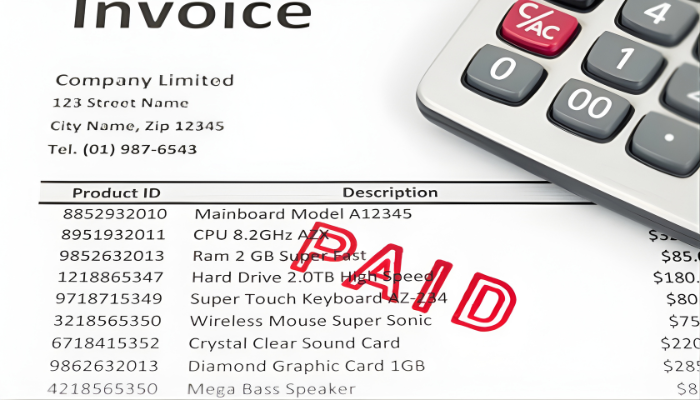
Invoice fraud is on the rise, and scammers are getting more creative with their tactics. Whether you’ve been in business for decades or are just getting started, invoice fraud can strike when you least expect it—and the impact can be severe. It’s not just about financial loss; it’s about protecting your business’s reputation and avoiding operational headaches. The best defense? Spotting the signs early and taking action before fraud finds its way into your bottom line.
Let’s look into some of the most common signs of invoice fraud and how you can protect your business with practical, actionable steps.
Inconsistent Invoices: Small Details, Big Red Flags
Have you ever received an invoice that just doesn’t look right? Maybe the payment details seem off, or the formatting looks different from what you’re used to. Even small changes in invoice numbers, bank details, or logos can be signs of tampering. Scammers often count on businesses letting their guard down, assuming no one will notice minor discrepancies.
💡Tip: Always compare new invoices to previous ones. Cross-check payment information and ensure the billing details match what’s on file. If something feels off, reach out to the vendor directly and verify the changes.
Contract Variations: Know Your Agreements Inside and Out
When you’re working with a new vendor or don’t have a long invoice history to reference, your master contract becomes your go-to safety net. This document outlines the agreed payment terms, services, and contact details—perfect for spotting inconsistencies. Scammers can sometimes intercept invoices and tweak crucial details like banking information, hoping the changes slip by unnoticed.
💡Tip: Get familiar with your contracts and train your team to double-check each invoice. Regularly compare invoices to the contract to ensure everything lines up. Don’t hesitate to confirm with the vendor if anything looks out of place.
Incorrect Purchase Information: If You Didn’t Order It, Don’t Pay for It
Receiving an invoice for goods or services you never ordered is a huge red flag. Fraudulent invoices often list incorrect items, services, or quantities that don’t match what you actually purchased. If your team isn’t paying close attention, these discrepancies can lead to overpayments—or worse, payments for things that were never delivered.
💡Tip: Double-check every invoice with the department responsible for the account. Make sure the quantities, prices, and descriptions align with what was ordered and received.
Overbilling: The Sneaky Extra Charges
One of the most common invoice scams involves overbilling. Scammers might inflate the cost of goods or services, tack on hidden fees, or charge for work that was never completed. Often, they rely on time pressure or legal threats to push businesses into paying without a thorough review.
💡Tip: Establish a consistent review process for all invoices. Always question unexpected charges, and if a vendor can’t explain them, consider it a red flag.
Unusual Payment Requests: Double-Check Changes
Even your most trusted vendors can be targeted by scammers. You might suddenly receive an email asking for payment to a different bank account or via a new method. While this can be legitimate, it’s also a common fraud tactic. Scammers might impersonate vendors, sending fake invoices and hoping you don’t verify the change before making the payment. This is also where having a secure vendor payment process becomes important. Having a system that includes checkpoints and verification steps helps ensure that you’re paying the right people and avoiding fraud.
💡Tip: Always verify changes in payment instructions directly with your known contact at the vendor. A quick phone call can prevent costly mistakes.
Suspicious Links: Don’t Click—Be Sure
Scammers often embed phishing links in invoices, hoping you’ll click and compromise your company’s security. These links might appear as part of a payment portal or disguised as a legitimate document.
💡Tip: You could use phishing link checkers to check suspicious links, but the best option is to avoid clicking any links in invoices. Instead, manually navigate to your vendor’s website or payment portal to ensure you’re dealing with a secure and legitimate source.
New Senders: A Sudden Change in Communication
It’s normal for businesses to have staffing changes, but receiving an invoice from someone you’ve never dealt with should raise a red flag. Scammers sometimes pose as new contacts from your existing vendors, hoping to catch you off guard with a fraudulent invoice.
💡Tip: Before paying an invoice from a new sender, confirm with your usual contact that someone new has joined their team. This extra step can save you from falling for an impersonation scam.
How Business Credit Reports Can Protect You
Want to add another layer of protection? Business credit reports offer insights into a company’s financial health, ownership structure, and payment history. By checking these reports, you can verify the legitimacy of your vendors and catch any inconsistencies that might signal fraud.
💡Tip: Regularly review business credit reports for all your vendors. If you notice any sudden changes in registered addresses or contact information, take it as a cue to investigate further.
Prevention Is Your Best Defense
Dealing with Invoice fraud doesn’t have to be overwhelming. By staying alert and implementing strong internal processes, you can safeguard your business from scammers. Encourage a culture of caution in your organization—teach employees to question anything unusual and stay proactive. Use tools like business credit reports to monitor your vendors and spot potential fraud before it escalates.
Remember, acting quickly and catching fraud early will keep your business safe and secure. Prevention truly is the best cure. Stay vigilant, and your business will be better protected against the growing threat of invoice fraud.
At Factor Funding, we know that managing cash flow while juggling day-to-day challenges can feel overwhelming. That's why we’re here to support you with flexible financial solutions that give you the breathing room to focus on what matters most—growing your business.
We’re committed to providing the insights and resources you need to help navigate these challenges confidently and keep your business moving forward.





















